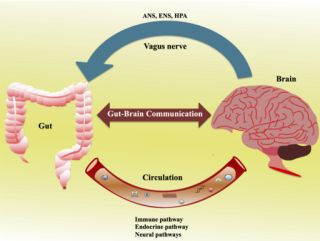Cognition
Inside Out: The Role of Bodily Awareness in Interpreting Art
Here’s the vital connection between the body, mind, and art.
Updated April 10, 2024 Reviewed by Ray Parker
Key points
- The experience of art is inherently emotional.
- Interoception, the awareness of internal bodily states, mediates these feelings.
- Interoception influences our psychological and emotional engagement with art.
My husband feels saddened when he views paintings by Edward Hopper. So do others. Hopper’s portrayal of people (Excursions into Philosophy, 1959), restaurants (Night Hawks, 1942), and houses (House by the Railroad, 1925) can induce a feeling of loneliness in us. They also suggest that Hopper was lonely.
The artist's perceived isolation and separateness are transferred to us through a process called interoception, which is explained as the capability of humans to sense internal bodily states. It is thought to play a crucial role in how humans experience art.

The Foundation of Interoception
Interoception encompasses the ability to perceive, process, and interpret signals from within the body, such as hunger, thirst, heart, and respiratory rates. This internal awareness is fundamental to our emotional and psychological well-being. Research in psychology and neuroscience suggests that interoception is linked to emotional experience, decision-making, and self-awareness (Craig, 2009). This awareness of internal bodily states contributes to the intensity and range of emotions we experience, which, in turn, affects how we perceive and interact with art. Whether it's the poignant sorrow in a piece of music, the serene tranquility in a painting, or the thrilling suspense in a piece of literature, art evokes a spectrum of emotions. These emotional responses can be deeply intertwined with our interoceptive awareness. For instance, a study by Jäncke, Kühnis, Rogenmoser, and Elmer (2015) found that music can induce changes in heart rate, suggesting a direct link between auditory stimuli and interoceptive sensations.
Moreover, the concept of "embodied simulation," a mechanism proposed by Gallese (2005), suggests that observing or engaging with art activates neural mechanisms in the observer's brain that replicate the state in the artwork. This process implies that our capacity to understand and feel art is mediated by our interoceptive knowledge of bodily states.
Evidence for a Psychological Basis
From a psychological standpoint, the art experience facilitated by interoception can be understood through several frameworks. One such is the "aesthetic triad," which integrates the brain's sensory-motor, emotion-valuation, and knowledge-meaning systems (Chatterjee & Vartanian, 2014). Interoception plays a pivotal role in this emotion-valuation system, where the body's internal states inform the emotional valence we assign to an art piece.
Additionally, the "embodied cognition" theory suggests that cognitive processes are deeply rooted in the body's interactions with the world (Wilson, 2002). Interoception, by providing a continuous stream of bodily signals, contributes to these cognitive processes, influencing how we perceive, interpret, and emotionally connect with art.
A recent study (Nummenmaa and Hari, 2023) highlighted the finding that artworks depicting human figures elicited the most robust responses in terms of both emotional and physical sensation, supporting theories around the sensorimotor mirroring effects induced by observing human actions. Although the study relied on subjective self-reports and did not include objective measurements of physiological changes, the results suggest that the perception of art is fundamentally an interoceptive process, engaging our awareness of internal bodily states. This phenomenon indicates that art uniquely resonates with us on a deeply personal level, altering our perception through a connection with our bodily experiences.
Evidence Beyond the Psychological
Antonio Damasio, a neuroscientist, has been instrumental in advancing our understanding of interoception and its significance in the broader context of neuroscience and psychology. Through his pioneering research and influential theories, Damasio elucidated the connection between the body, brain, and mind, challenging traditional views of emotion and cognition as separate entities (Damasio, 1994)
One of Damasio's key contributions is the somatic marker hypothesis, which posits that bodily states generated in response to emotional stimuli are integrated with cognitive processes, assisting in decision-making and social behavior. This hypothesis underscores the importance of interoception, as it suggests that the “gut feelings” or bodily intuitions we experience can significantly influence our cognitive processes and decision-making. According to Damasio, these somatic markers are crucial for navigating complex and uncertain environments, allowing individuals to make decisions quickly and effectively by referencing past experiences that produced similar bodily states.
Conclusion
By mediating our awareness of internal bodily states, interoception significantly influences our psychological and emotional engagement with art. It enriches the art experience, deepening our emotional responses and enhancing our appreciation of artistic expressions. Understanding the role of interoception in the art experience offers valuable insights into the psychological processes that underlie our interactions with art, highlighting the important connection between the body, mind, and art.
References
Craig, A.D. (2009). How do you feel—now? The anterior insula and human awareness. Nature Reviews Neuroscience, 10(1), 59-70.
Jäncke, L., Kühnis, J., Rogenmoser, L., & Elmer, S. (2015). Time course of EEG oscillations during repeated listening of a well-known aria. Frontiers in Human Neuroscience, 9, 401.
Gallese, V. (2005). Embodied simulation: From neurons to phenomenal experience. Phenomenology and the Cognitive Sciences, 4(4), 23-48.
Chatterjee, A., & Vartanian, O. (2014). Neuroaesthetics. Trends in Cognitive Sciences, 18(7), 370-375.
Wilson, M. (2002). Six views of embodied cognition. Psychonomic Bulletin & Review, 9(4), 625-636.
Nummenmaa, L., & Hari, R. (2023). Bodily feelings and aesthetic experience of art. Cognition and Emotion, 37(3), 515–528. https://doi.org/10.1080/02699931.2023.2183180
Damasio, A. (1994). Descartes' Error: Emotion, Reason, and the Human Brain. New York: Avon Books.


